- Home
- Robert Graysmith
The Laughing Gorilla: A True Story of Police Corruption and Murder
The Laughing Gorilla: A True Story of Police Corruption and Murder Read online
Table of Contents
Title Page
Copyright Page
Dedication
ONE
TWO
THREE
FOUR
FIVE
SIX
SEVEN
EIGHT
NINE
TEN
ELEVEN
TWELVE
THIRTEEN
FOURTEEN
FIFTEEN
SIXTEEN
SEVENTEEN
EIGHTEEN
NINETEEN
TWENTY
TWENTY-ONE
TWENTY-TWO
TWENTY-THREE
TWENTY-FOUR
TWENTY-FIVE
TWENTY-SIX
TWENTY-SEVEN
TWENTY-EIGHT
TWENTY-NINE
THIRTY
THIRTY-ONE
THIRTY-TWO
THIRTY-THREE
THIRTY-FOUR
THIRTY-FIVE
THIRTY-SIX
THIRTY-SEVEN
THIRTY-EIGHT
THIRTY-NINE
FORTY
FORTY-ONE
FORTY-TWO
FORTY-THREE
FORTY-FOUR
FORTY-FIVE
FORTY-SIX
FORTY-SEVEN
FORTY-EIGHT
FORTY-NINE
FIFTY
Acknowledgements
Author’s Note
Selected References
Index
Robert Graysmith’s Published True Crime Books:
ZODIAC
THE SLEEPING LADY
AUTOFOCUS (THE MURDER OF BOB CRANE)
UNABOMBER: A DESIRE TO KILL
THE BELL-TOWER
ZODIAC UNMASKED
AMERITHRAX
Zodiac, Zodiac Unmasked, and AutoFocus have been made into
major motion pictures by Warner Brothers, Paramount,
Phoenix Pictures, and Sony Pictures.
THE BERKLEY PUBLISHING GROUP
Published by the Penguin Group
Penguin Group (USA) Inc. 375 Hudson Street, New York, New York 10014, USA
Penguin Group (Canada), 90 Englinton Avenue East, Suite 700, Toronto, Ontario M4P 2Y3 Canada (a division of Pearson Penguin Canada Inc.)
Penguin Books Ltd., 80 Strand, London WC2R 0RL, England
Penguin Group Ireland, 25 St. Stephen’s Green, Dublin 2, Ireland (a division of Penguin Books Ltd.)
Penguin Group (Australia), 250 Camberwell Road, Camberwell, Victoria 3124, Australia (a division of Pearson Australia Group Pty. Ltd.)
Penguin Books India Pvt. Ltd., 11 Community Centre, Panchsheel Park, New Delhi—110 017, India
Penguin Group (NZ), 67 Apollo Drive, Rosedale North Shore 0632, New Zealand (a division of Pearson New Zealand Ltd.)
Penguin Books (South Africa) (Pty.) Ltd., 24 Sturdee Avenue, Rosebank, Johannesburg 2196, South Africa
Penguin Books Ltd., Registered Offices: 80 Strand, London, WC2R 0RL, England
This book is an original publication of The Berkley Publishing Group.
The publisher does not have any control over and does not assume any responsibility for author or third-party websites or their content.
Copyright © 2009 Robert Graysmith.
All rights reserved.
No part of this book may be reproduced, scanned, or distributed in any printed or electronic form without permission. Please do not participate in or encourage piracy of copyrighted materials in violation of the author’s rights. Purchase only authorized editions.
BERKLEY is a registered trademark of Penguin Group (USA) Inc.
The “B” design is a trademark belonging to Penguin Group (USA) Inc.
Library of Congress Cataloging-in-Publication Data
Graysmith, Robert.
The laughing gorilla : a true story of police corruption and murder / Robert Graysmith. p. cm.
Includes bibliographical references and index.
eISBN : 978-1-101-14518-0
1. Nelson, Earle Leonard. 2. Gordon, Harry. 3. Murderers--United States--Biography.
4. Murder--United States. 5. Dullea, Charles W., 1889-1966. 6. Police chiefs--California-- San Francisco I. Title
HV6245.G.152’30979461--dc22
http://us.penguingroup.com
The Laughing Gorilla haunted the last honest cop in San Francisco. Captain of Police Inspectors Charles Dullea felt there was nothing worse than a cop killer. Nothing worse, he thought, unless it was a dirty cop or a killer cop. In the early 1930s he encountered all three—and soon after something worse lumbered out of his darkest nightmare—laughing.
The Setting—1930s San Francisco. The city’s Ferry Building, Moorish Clock Tower, and docks are a fog-shrouded region of bloody labor riots. Depression times, bad times—poverty, soup lines, and the most corrupt police department in America. The city hall, the DA, and the cops run the town as though they own it, and they do.
The Quarry—A long-armed Gorilla Man who strangles with his huge hands and dissects his victims in autopsies with a straight razor. He is the nation’s first traveling serial killer.
The Protagonist—Captain Dullea, an ex-Marine, encounters a new kind of man and new kind of crime—motiveless sequential murder, “the greatest reign of terror ever inflicted on the nation’s women.” Why is the mystery he cannot solve. Who is the answer he never suspected.
The Antagonist—Police Chief William J. Quinn, brutal, anti-labor chief who shotguns and gases striking longshoremen as the docks go up in flames. His cops have individual bank accounts of up to $830,000. Quinn cannot be shaken from his office. Dullea intends to make certain he is.
The Prime Suspect—Slipton Fell, movie-star handsome and instantly attractive to women, especially older ones. The “Laughing Killer of Woodside Glens” lives within a half block of the Bay Hotel where “The Murders in the Rue Morgue” come to life and is identified by the staff as the killer. But is he the one Dullea’s seeking? In Cleveland, Eliot Ness pursues another Gorilla Man who might also be Dullea’s man.
To Brad Fischer and James Vanderbilt
ONE
As the sailor looked in, the gigantic animal had seized Madame L’Espanaye by the hair and was flourishing the razor about her face, in imitation of the motions of a barber.
—E. A. POE, “THE MURDERS IN THE RUE MORGUE”
“ARE you Mrs. Clara Newman?” the whispered voice asked through a slit that served as a mouth. “Are you the lady who advertised a third-floor room for rent?” The stranger’s watery blue eyes fastened on Clara Newman’s face, then on the expensive pearls around her neck, and finally on her frail throat. The Gorilla Man laughed, a mirthless laugh at the bottom of a dusky staircase.
The olive-complected stranger seemed nice enough, except for his vaguely simian features—broad nose, a wet mouth too long for his face, and small low-set ears. Beneath his short, straw-colored hair Clara saw a Y-shaped wound, wet as his lips, which was not quite healed. For a short man, five feet, seven or eight, he had a powerful build—as muscular as the gorillas he resembled—wide shoulders, broad chest, long arms, and short legs.
His huge hands were corded with muscle. Even in the dim light Clara could see they were covered with light-colored tufts of hair. The joints of his fingers were swollen, the balls of his thumbs extraordinarily broad and square, and the joints in the long flexors of his thumbs much longer than average. The snapping and catching of his thumb, a “gamekeeper’s thumb,” were due to a thickening of the sheath and tendon at the metacarpal head. The repeated action of twisting
the heads off small animals forces the thumb into radial deviation at the joint. His nails, a half inch long or more, curved sharply inward. Even as a child his hands had been large and continuously in motion, except when clasped rigidly in prayer. As an adult he sometimes walked on them—easing forward onto his knuckles, straightening his legs and ambling forward with uncanny ease. He suffered from violent migraines that troubled him all his life. At times, the pain was so overwhelming he could not walk except on his hands.
The sanctimonious young man in the vestibule of Clara Newman’s rooming house hoisted the heavy Bible under his arm as if it weighed nothing. By God, he loved that Bible! The worn, well-thumbed volume with rich leather covers and embossed gold inscriptions had been handed down from his widowed grandmother to his aunt Lillian, a rabid Pentecostal Bible-thumper. From Lillian’s saintly, hated hands it had come down to him. But the Gorilla Man’s own restless hands had worn away the gold leaf, scuffed the gold-sided pages, blackened the bound-in cord marker, and smeared the octavo pages where he’d double-lined, even triple-lined in ink his most cherished verses. “My aunt told me I would be a minister some day,” he told Clara Newman.
While it touched her heart to hear that he loved God, she thought it would be exceedingly odd to see that long, simian mouth recite Scripture.
The Gorilla Man wore a shabby, dark gray suit; a white shirt; a wide, yellow tie with a hand-painted palm tree; and a tan Stetson too large for him. He routinely returned home in someone else’s clothes. He had just been shaved and barbered, though his overhanging brows remained un-trimmed. Because he needed only a thick ridge of bone above his eyes to make him perfectly apelike, those heavy brows fulfilled that function. Beneath their canopy his deep-set eyes shimmered like well water. They darkened to indigo as Clara studied them, failing to notice their animal cunning. Turning, she led him to the second floor. On the third-floor landing the Gorilla Man’s long fingers spread wide. He flexed them—snap-snap-catch- snap—and laughed.
CAPTAIN of Police Inspectors Charles W. Dullea awoke with a start, drenched with sweat and shaking. Greenish yellow light was streaming through his bedroom curtains. After a rainy night and overcast dawn, high-stepped banks of clouds to the east had parted to permit an unearthly illumination to drench San Francisco. Dullea wiped his brow as he sat up. He had been dreaming of the Gorilla Man again.
His hands were trembling as he shaved, drawing the blade of the old straight razor from his marine days across the line of his jaw. He shook the lather into the sink and applied astringent alum to a shaving cut. Dullea had been the responding officer in the Gorilla Man investigation, an unparalleled case with an unparalleled creature and a death toll akin to a war or natural disaster. A detective lieutenant then, he never forgot standing on the second-floor landing of Clara Newman’s boardinghouse unable to lift a foot farther into the refurbished attic where the killer had left her nude, violated body. Dullea had actually experienced horripilation—gooseflesh that made his hair rise .
At first the local papers called Clara’s killer “the Dark Strangler,” but his great strength and husky apelike build soon earned him another sobriquet, “the Gorilla Murderer,” then, because it looked better on the banner, “the Gorilla Man.” The press bestowed no nicknames on Captain Charles Dullea. They knew him simply as “Charlie” as did a thousand in the SFPD and many more thousands of citizens throughout the Bay Area. He had an affable face, a face you’d welcome at a tavern. His bushy black hair was cut short, and though he’d make attempts at parting it, the wind always defeated his efforts. His lips were thin as razor blades, his eyes cool and lazy as the Bay and as unreadable. Like the Bay, he was filled with deep and unexpected currents. Well proportioned, a solid 205 pounds spread evenly over a trim six-foot, one-inch frame, the dignified detective was seemingly as wide shouldered as the city’s Ferry Building and as tall as its Moorish Clock Tower. His movements were economical, measured, and self-confident, those of a first-rate athlete and ex-soldier. But once roused to action, Dullea was quick thinking and quick acting, filled with more passion than anyone would ever expect. Unfortunately, he was an honest cop on the most corrupt police force in the nation. He just didn’t know it was dirty yet.
Dullea dressed in a freshly ironed shirt, dark vest, and six-button double-breasted suit. His throat was tight. Methodically, he knotted his red-striped tie and tucked the twin peaks of a folded white handkerchief into his breast pocket. A touch of the farm boy clung to him. His suits never really seemed to fit, and his trousers were always a bit too short. His pointed black shoes, laced to the ankle, looked uncomfortable and were.
Over a late breakfast with his wife, Winifred, and baby, John (Charlie Jr., the eldest, and Eddie, the middle child, were already at school1), he opened his morning Chronicle and read the date—April 29, 1930. Yes, it had been four years since the Gorilla Man spoke those hushed words—“Are you Mrs. Clara Newman?” Ultimately, the long-armed strangler had wriggled out of Dullea’s West Coast dragnet and escaped across the country as the first traveling serial killer in the nation’s history. Dullea still castigated himself for not being able to save Clara Newman and over two dozen others, including a six-month-old infant, from strangling and then rape. Dullea kissed Winifred good-bye, centered his high-crowned hat, and left the house. Outside he saw the sky had turned green. Not knowing what to make of this odd occurrence, he climbed behind the wheel and drove to the Hall of Justice. He watched the morning sky until no green remained, only a growing darkness.
AT 9:52 A.M. a bullet hole surrounded by streamers of light appeared in the skies above San Francisco. Pilot Bill Fletcher, at the controls of a powerful Stearman biplane, circled Mount Tamalpais to the north. Then he headed southwest and nosed straight up into the great rift. Fifteen thousand feet above the Pacific, the lens on his fixed wing camera froze over. His gloved hands became frigid. Above Fletcher, “Baily’s beads” surged clockwise around a moving black hole. He switched on his oxygen, kept climbing, and ascended into a darkening fissure many thousands of miles long. As the enormous rupture crawled northeast it cast a half-mile-wide shadow over San Francisco and plunged the temperature below by nearly twenty degrees. Ground level, at the wheel of his cab, Captain Driver Harry Gibson felt his fingers grow as numb as Fletcher’s. He flexed them, craned his head out the cab window, and studied the blackening heavens with widening eyes. He put his cab in gear and crept to the intersection of California and Montgomery streets, all the while peering upward.
At 9:58 A.M. two well-dressed gents—paymaster Morris B. Murphy, thin, bespectacled, and nearly hairless, and office manager Max Kahn, pallid and double-chinned—exited a branch of the Bank of Italy. Under his arm, Murphy clutched a black leather grip stuffed with $4,000 in small bills. Nervously, both men scanned the green sky, flagged down Harry’s cab, and scrambled into the rear seat. As the cab edged along the shadow path, the squeal of street cars and growl of motors gradually faded away. The shuffle of ten thousand feet ceased. People stopped to watch the skies. As if holding its breath, the bustling metropolis grew deathly silent. Its heartbeat ceased.
By 10:14 A.M. a third of the sun had been eaten away. Lights sprang on in diners, dingy hotels, and the half-filled office buildings of failed businesses. Hundreds atop the lofty Pacific Telephone and Telegraph Building held up pieces of smoked glass and squinted at the moon inching its way across the sun. One man lighting matches to make smoked glass set fire to City Hall. At San Quentin State Prison, “Killer” Kid McCoy and LA’s crooked DA Asa Keyes (ostracized by other prisoners) caught the sun’s reflection in a water bucket and watched the rare spectacle that way. The last total eclipse had occurred five years earlier over New York. There wouldn’t be another for two years, and that over Maine and New Hampshire, not San Francisco.
By the time Harry angled his cab up on the bulkhead between Piers 26 and 28, the eclipse had blanketed a half-mile width. He rolled to a stop at the entrance to the Stevedoring and Ballast Company as a waiting man stepped
from the shadows. “He wore a good Herringbone suit that had seen better days,” Harry recalled. “The only thing new about him was his big shiny revolver.”
By 10:36 A.M. half the sun was gone.
By 10:57 A.M. the last bright sliver was blotted out as the eclipse reached totality. Its shadow swept across the earth at terrific velocity—half a mile a second. By 10:59 A.M. the moving bullet hole, outlined by flickering flame, split the sky above Napa County. By 11:00 A.M. it darkened Woodland in Yolo County. Its advance over the hills was marked by a halo fifty miles in diameter. By 11:02 A.M., amid the high altitude, tall trees, and bright flowers of Bishop Ranch in Yuba County, Dr. Robert Altken waited at Comptonville along the path of totality. He tinkered with two delicate spectrographs, adjusted angstrom units to violet blue and orange red wavelengths and captured the flickering corona as it swept over him a minute later. His bones went chill. Soaring from a lake, two amphibian planes with red stripes took up the chase until they were outdistanced. For a little over an hour dusk shrouded the San Francisco morning. Within that daytime darkness all manner of things were done by all manner of men, but in the same old familiar ways since Cain killed Abel.
BY 1:37 P.M., the time Captain Dullea arrived, the pond-size stain next to Pier 26 was barely tacky on the well-trodden concrete. As he parked his car, he surveyed the waterfront. Eleven miles of jutting piers aligned along the arched northern and southeastern sections give the Embarcadero the appearance of a gap-toothed smile that commences with the sooty factories and freight yards of the S.P. Depot at Third and Townsend. From there it curves north for several blocks before beginning its abrupt arc to the northwest to terminate at Fisherman’s Wharf. Dullea could see the Ferry Building a few blocks away, midpoint in an area called the City Front. Defined on the south by even-numbered private piers and warehouses, the Ferry Building is bounded on the northeast by odd-numbered, state-owned pier sheds and industrial plants. East Street, which fronts the Embarcadero, dipped briefly into a tunnel at Market Street and reemerged near Washington Street at a huge Camel cigarettes billboard near the Bay Hotel.

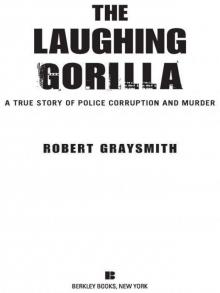 The Laughing Gorilla: A True Story of Police Corruption and Murder
The Laughing Gorilla: A True Story of Police Corruption and Murder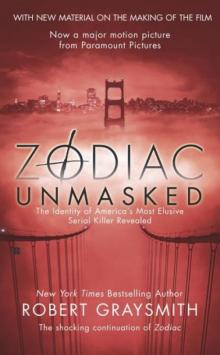 Zodiac Unmasked: The Identity of America's Most Elusive Serial Killer Revealed
Zodiac Unmasked: The Identity of America's Most Elusive Serial Killer Revealed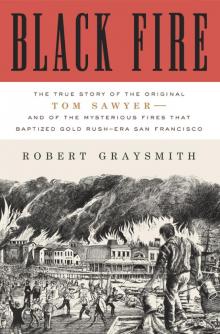 Black Fire: The True Story of the Original Tom Sawyer
Black Fire: The True Story of the Original Tom Sawyer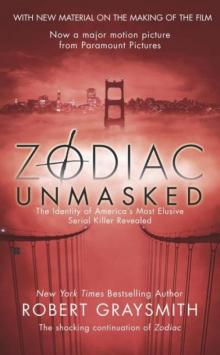 Zodiac Unmasked: The Identity of America's Most Elusive Serial Killers Revealed
Zodiac Unmasked: The Identity of America's Most Elusive Serial Killers Revealed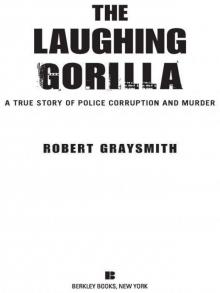 The Laughing Gorilla
The Laughing Gorilla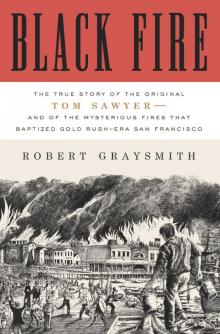 Black Fire
Black Fire